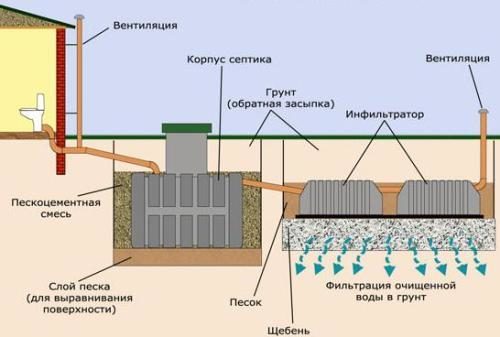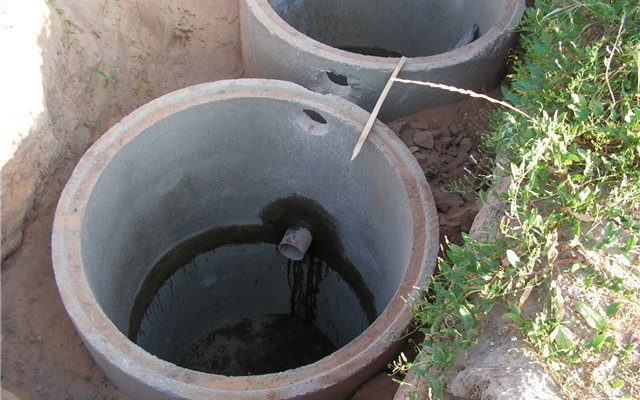Intensive growth rates of suburban areas often have great difficulties. The construction of the necessary infrastructure, as a rule, does not keep up for the construction of cottages. It happens that after the end of the construction of a house in the village at best there is electricity, and water supply, sewage and gas are absent, since the costs of their construction with a small number of potential subscribers are unjustified. If instead of gas, it is possible to use electricity, and water in the presence of the latter is made from the well directly in the site, then it is more complicated with the sewage system. Ordinary cesspools that were used over the centuries do not solve this problem. First, they need to constantly pump out, and secondly, falling into the ground, uncleans can contaminate groundwater. This will make it impossible to use wells or wells.
Content
Modern technologies make it possible to use new wastewater treatment methods - so-called septic tanks. On how to install a septic tank with their own hands installing and the principle of work, let's tell later.
Types of septicov
Septic machines are considered to be devices for wastewater collection, followed by their removal or filtering. Septic colors are divided by:
- The principle of action.
- Production material.
- By way of location.
According to the principle of action of septicities, there are:
- Leather. It is an ordinary cesspool. Installation is possible only in the case of sanitary standards, the normal drainage ability of the soils, and the absence of surface soil norms. Celdictions can serve as a source of soil infection by bacteria. Currently used rarely.
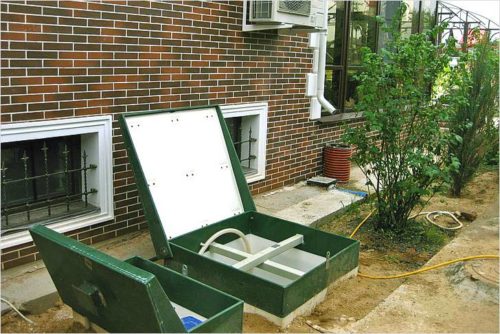
- Sealed septic. The simplest septic machines are sealed containers in which drains are collected. As they accumulate, they are pumped out with the help of special machines, after which they are taken into the fields of filtration or merge into the nearest sewer collector.
- Septic tanks with wastewater treatment. Modern technological systems with water purification degree up to 99%. Allowed to save water to significantly, which, after cleaning, can be used for technical purposes (washing, watering, etc.), and also exclude bacteria in the soil. Although the cost of such septicists in comparison with ordinary tanks is more, however, it is more than compensated by ease of operation.
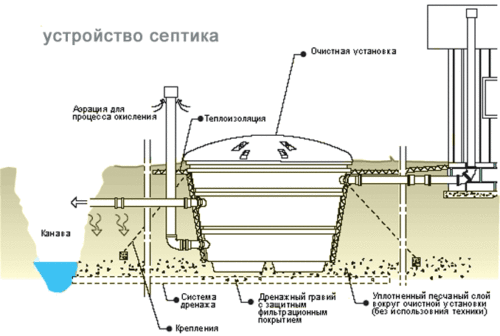
According to the material of the manufacture of septicities there are:
- Concrete (monolithic or collected from concrete rings).
- Brick (laid out of a brick in 1 row).
- Steel. Apply quite rarely. Steel is very susceptible to corrosion, and taking into account the aggressiveness of wastewater, the service life of such a septic will not be too long. Application of several layers of protective coating will not save the situation, since it is short-lived, but to carry out the repaint of the internal surfaces is very expensive.
- Plastic. Newer systems. Make them of durable polyethylene, which is able to withstand any load. In addition to the long service life, plastic septic colors have a relatively low weight, which greatly facilitates the process of their installation.
By way of location:
- Vertical.
- Horizontal.
The first is essentially saved by the area of \u200b\u200bthe site, however, they require deep-pitted digging.
The principle of the treatment of septic septicists and the benefits of their use

Septic tanks for deep sewage treatment are two types:
- Two-section.
- Three-section.
Two-section. It consists of two sections, which are represented in the form of a receptacle which is divided into two compartments, or two containers connected by a jumper pipe. The principle of operation of such a device is as follows:
- Wastewater flows into the first chamber, where they are mechanical separation into a coarse fraction and fine. Heavy particles eventually settle to the bottom of the chamber, and "clarified" water rises up, and then poured into the second chamber. Chambers are connected by such a way as to prevent ingress of harmful sediment into the second chamber.
- Further, in the second compartment septic tank for sewage treatment are taken anaerobic bacteria. In the process of their life they decompose organic matter, which is still in a "clarified" the water, purifying it. During the fermentation, the water is cleaned from residues of organic impurities at this released methane gas.
- After that, the two-piece system, the water enters the so-called filtration field. The latter is a trench, the bottom of which the layers of sand and gravel packed. Going through such a natural filter, the water is purified more than 90%, which meets the sanitary norms and falls into the ground.
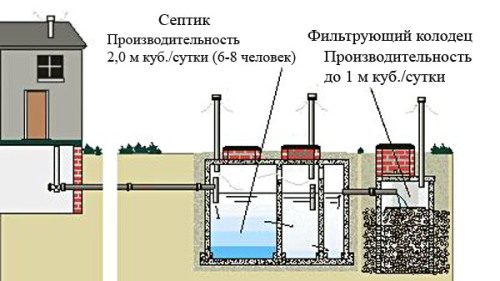
Three-chamber system provides water purification chamber in which aerobic bacteria passes vital process. They live only in the presence of air, which supplies the compressor chamber. The water after the third chamber can be used in a secondary circuit, because the degree of purification reached 99%.
In operation, a septic tank at the bottom of each of its cells a small amount of precipitate as sludge. From time to time it must be pumped out by means of the drain pump and remove.
The advantages of septic tanks to pit latrines are obvious:
- No unpleasant odors at the site.
- Lack of soil contamination probability sewage.
- Possibility of recycling of purified water.
How to install a septic tank

Although usually the companies that sell this equipment, offering its professional installation, you can do it yourself, and thus save money. Before you mount the septic tank, it is necessary to choose the capacity of the equipment. It depends on the volume of wastewater. It can be calculated very simply: see water consumption over the counter. The amount of water will be roughly equal to the number of drains. The simplest system is designed for processing of 1 m 3 per day.
All the technology installation septic tank with your hands can be divided into 3 parts:
- Earth and preparatory work.
- Installation of equipment and checking the system.
- Warming and powder system with soil.
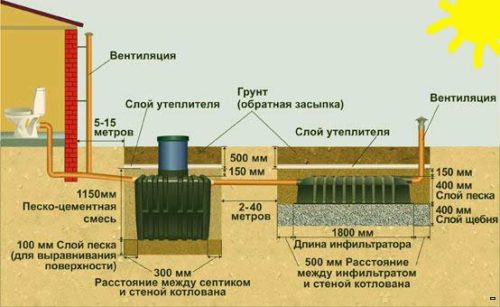
The procedure for carrying out installation of the septic tank:
- Preparatory work consist in drawing up the installation scheme of the septicity with their own hands, choosing a plot and selection of pipes and connections. Septic tank can be located in well-drained soils, where the level of groundwater is not too high.
- Septic must be located as close to the house, since a large distance between them will require a larger tilt of the pipe, and, accordingly, and greater than the depth of the trench for the septic.
- It is also worth considering the possibility of an entrance of the car for pumping the scale formed in the pots. Although, with the correct operation of the system, the pumping system is carried out no more than 1 time in 2-3 years, there must be free access to the containers. Most septicines in their work use electricity for the operation of compressors and circulation pumps. When using these models, it is necessary to provide access to the power wire to the installation site of the equipment.
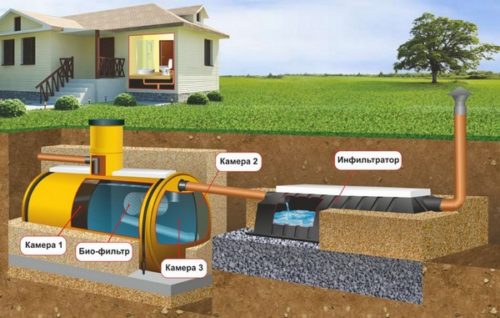
- Drive for installation is digging or manually, or with the help of special equipment. Its depth is determined by the parameters of the specific equipment. As a rule, on the walls of the tanks, manufacturers apply the level of zero mark. If the reclining will dig a manually, you need to make the caisson. It will retain the walls of the trench from the foaming, which can lead to injury if someone will be in it. If the septic tank consists of 2-3 tanks, then the long trench is digging so that the distance between them was 1-2 meters.
- A trench of 0.5 meters wide and a depth of about 1 meter is digging up from the sewage pipe out of the sewage pipe. It is worth noting that the depth is determined depending on the depth of the primer of the soil, as well as the height of the location of the receiving flange.
- At the bottom of the trench, the layer of sand is stacked, which is thoroughly tamped. The correct installation of the septic tank provides for styling the pipe under a slope. The lower point should be at the receiving flange, the top - at the outlet of the house. The pipe should not have a knee more than 30 °, the turns at right angles are unacceptable. Otherwise, she will be clogged.
- The angle of tilt pipe depends on its diameter. So, for a pipe with a diameter of 50 mm, the height of the inclination should be 30 mm, and for a pipe with a diameter of 160 mm - only 8 mm.
- On the bottom of the trench, where the septic will be installed, the sand layer and rubble will be added.
- When all preparatory work is over, you can start installing the equipment. In order to lower the cumbersome container in the trench, you will need a help of several people. When installing each container, check its position in the level. Skotes in one of the parties may affect the efficiency of the equipment.
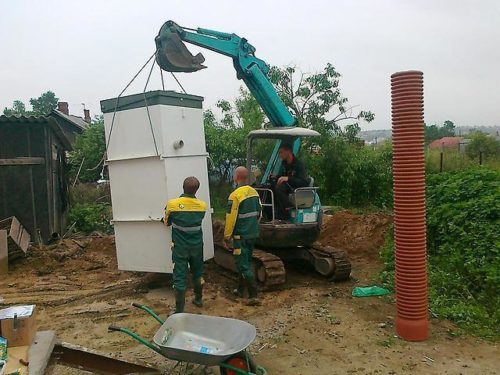
- When the containers are set, you can connect pipes. It is necessary to do it carefully to prevent the system deployment during operation.
- After the pipes are connected, the wiring is supplied and connected to the electrical part of the system.
- If the purified water is planned to be used for irrigation, after the third stage, the drive is installed, to which the drainage submersible pump is connected, otherwise the rings are set without the bottom. Through them, water will go into the ground.
- When all the elements of the system are installed, and it itself is checked for performance, it remains to sprinkle them with sand and tamper. Tamping is carried out only manually, as the use of technology can damage the containers.
